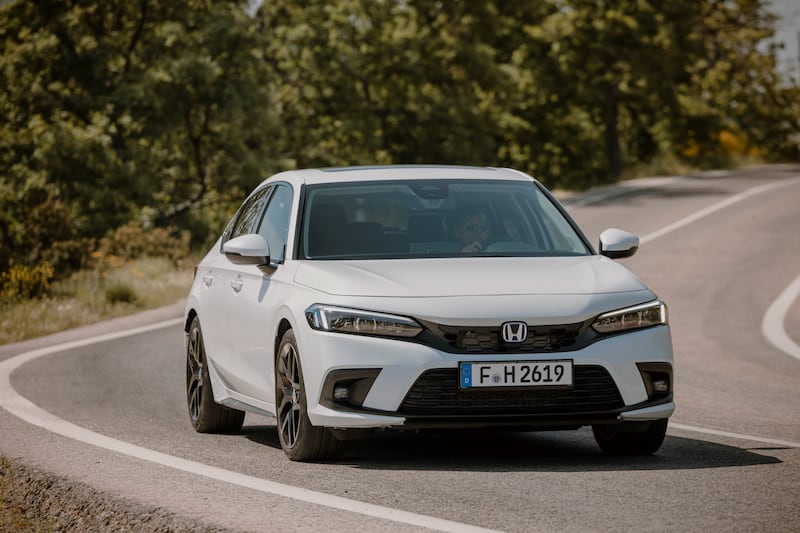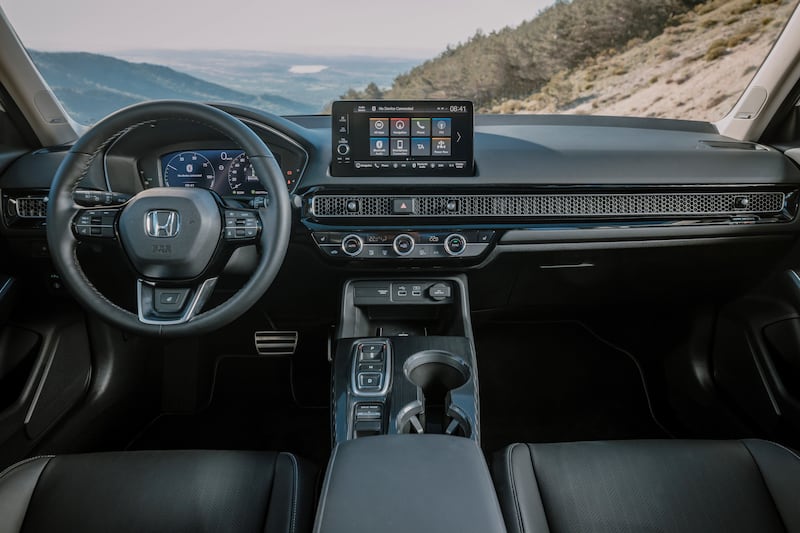It’s been 50 years since Honda launched the first, diminutive Civic on to the world’s driveways. That first-generation Civic was a fuel-sipping tiddler – just 3.4m long – which arrived with 48mpg fuel economy just as the world was about to slip into the great 1970s energy shock.
Sound familiar? Well, as we spiral into a new energy crisis, Honda’s trying to pull off something of a similar trick with this all-new Civic, which ditches the petrol and diesel engine offerings of the previous, 10th-generation model and arrives with a singe 2.0-litre petrol-hybrid engine.
Well, I say arrives – it won’t be in Ireland until the end of this year, and is realistically a 2023 model. There’s also the dangling question of just how much Irish car buyers will care – the previous Civic, a hugely talented and reliable car, simply fell off most people’s buying radars.
Indeed, it seemed for a while as if Honda might abandon the European market altogether, shuttering its factory in Swindon in the UK in the wake of Brexit, and seeing its sales fall significantly across the continent. Given how huge and lucrative the home Japanese market, and the vast US market, are for Honda, you could see the logic of an exit.

Thankfully, that doesn’t seem to be happening. Honda is planning a European model blitz, starting with last year’s H-RV crossover, continuing with this new Civic, and ramping up next year with an all-electric crossover (called, torturously, the EN-Y One), a new Qashqai-sized hybrid called the Z-RV, and an all-new C-RV range-topper, with both hybrid and plug-in hybrid powertrains. Honda also says that it will launch 30 new all-electric models by 2030, and is partnering with both Sony (to develop cars for the Sony brand, and use Sony’s expertise in sensors and imaging systems) and General Motors (to develop long-range solid-state batteries).
Amid all these developments, the new Civic might seem a touch vanilla. It’s a far smoother-looking car than its predecessor, with fewer aggressive lines and no extraneous angles. It’s a quietly handsome car, but hardly what you’d call memorable, nor striking.
Inside though, things are much better. While the previous Civic’s actual build quality was never in doubt, it did suffer from a messy and cheap-feeling cabin. Not this one – the interior takes the pared back simplicity of the new H-RV and adds higher levels of touchy-feely quality to it. The all-digital instrument cluster is neatly laid out and easy on your eyes, while the nine-inch touchscreen features much-improved graphics and software.
Thankfully, Honda has been intelligent enough to leave some functions – stereo volume, heating and air conditioning – to old-fashioned physical buttons. There’s also a nice detail in that the air vents are larger than usual, and styled so that they appear to stretch the entire width of the dash. You change the direction of the airflow using wonderfully tactile little levers, that recentre with a neat and expensive-sounding click. A small detail, but a very pleasing one.

There’s plenty of room in the front, and the seats are comfortable, like armchairs. In the back, there’s more legroom than before thanks to a longer wheelbase, so rear-seat space is closer to something like a Mondeo or Passat. The boot, at 412 litres, is perhaps not as impressive as it used to be, but the luggage cover that retracts to one side, making it easier and simpler to fold down the back seats, is a neat touch.
The boot floor does have an awkward step in it, but that is to make room for the hybrid battery and power control unit. Honda is very proud of its e:HEV hybrid set-up and has made some significant improvements on the system fitted to the H-RV and C-RV.
The 2.0-litre petrol engine has been upgraded to direct fuel injection, while the software for the e-CVT gearbox (which actually doesn’t have any gears at all, but instead uses a pair of electric motors to send power and torque to the wheels) has been updated to try to create a more traditional gearboxy feel to the Civic’s acceleration.
It works, thankfully. As with all hybrids, the engine will drone a bit when you ask for acceleration, but there are neat little simulated gearchanges which make the noise less of an issue. Besides, the new Civic’s impressive refinement means that you don’t really hear a lot of noise at all.

It’s also a hugely economical engine. Over a route that took in the mountain roads from Madrid to San Lorenzo de El Escorial, as well as motorways, country roads and city streets, we easily averaged 4.5 litres per 100km, and that was mostly driving in Sport mode because… well, because all journalists are hooligans at heart.
Sport mode does seem like a bit of a misnomer, though. The Civic generally feels like a very relaxing car to drive. The ride quality is exemplary in its smoothness, while the lack of cabin noise and the squishy seats should make it an excellent long-haul travel device. Sporty, though? Honda bills this as the “drivers’ hybrid” but at first, that seems a bit wide of the mark.
Press on a bit, though, and the Civic does start to come to life a little. The steering has excellent weight, and some feel and feedback about what the front tyres are up to, so you can actually set into quite a nice rhythm on a twisty road. Ultimately, the soft suspension means that the Civic wallows a bit when asked to change direction rapidly, but there are inherently good manners here, which bode well for the powerful Type R version that arrives next year.
Good enough to take on the big-selling Toyota Corolla? Oh yes. The Civic’s styling might not be as enticing as that of the Toyota, but its interior is far better – much roomier, with a vastly bigger boot, and with quality levels that are at least as good – and its hybrid set-up seems to be at least as frugal as that of the Toyota, possibly even more so.
Will Irish buyers sit up and take notice this time around? One hopes so – the new Civic might be quiet, both in style and in the cabin, but it deserves to have some noise made about it.














